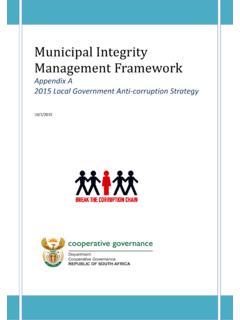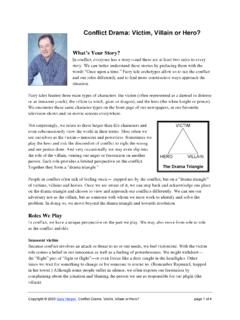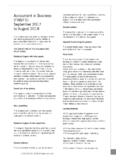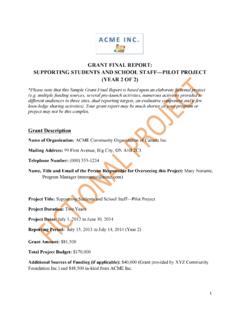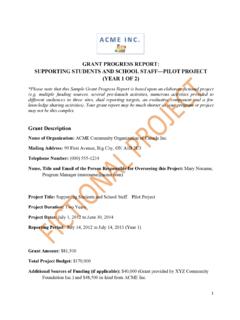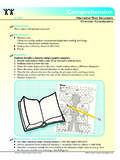Transcription of OECD Due Diligence Guidance for Responsible Supply Chains ...
1 OECD Due Diligence Guidance for Responsible Supply Chains of Minerals from Conflict-Affected and High-Risk Areas Third Edition OECD Due Diligence Guidance for Responsible Supply Chains of Minerals from Conflict-Affected and High-Risk Areas This document and any map included herein are without prejudice to the status of or sovereignty over any territory, to the delimitation of international frontiers and boundaries and to the name of any territory, city or area. Please cite this publication as: OECD (2016), OECD Due Diligence Guidance for Responsible Supply Chains of Minerals from Conflict-Affected and High-Risk Areas: Third Edition, OECD Publishing, Paris. ISBN 978-92-64-25238-7 (print). ISBN 978-92-64-25247-9 (PDF). Photo credits: Cover Corrigenda to OECD publications may be found on line at: OECD 2016.
2 You can copy, download or print OECD content for your own use, and you can include excerpts from OECD. publications, databases and multimedia products in your own documents, presentations, blogs, websites and teaching materials, provided that suitable acknowledgment of OECD as source and copyright owner is given. All requests for public or commercial use and translation rights should be submitted to Requests for permission to photocopy portions of this material for public or commercial use shall be addressed directly to the Copyright Clearance Center (CCC) at or the Centre fran ais d'exploitation du droit de copie (CFC) at FOREWORD. Foreword T he OECD Due Diligence Guidance for Responsible Supply Chains of Minerals from Conflict-Affected and High-Risk Areas ( the Guidance ) is the first example of a collaborative government-backed multi-stakeholder initiative on Responsible Supply chain management of minerals from conflict-affected areas.
3 Its objective is to help companies respect human rights and avoid contributing to conflict through their mineral sourcing practices. The Guidance is also intended to cultivate transparent mineral Supply Chains and sustainable corporate engagement in the mineral sector with a view to enabling countries to benefit from their mineral resources and preventing the extraction and trade of minerals from becoming a source of conflict, human rights abuses, and insecurity. With its Supplements on Tin, Tantalum, Tungsten and Gold, the OECD Guidance provides companies with a complete package to source minerals responsibly in order for trade in those minerals to support peace and development and not conflict. The Guidance was developed through a multi-stakeholder process with in-depth engagement from OECD and eleven countries of the International Conference on the Great Lakes Region (Angola, Burundi, Central African Republic, Republic of Congo, Democratic Republic of Congo, Kenya, Rwanda, Sudan, Tanzania, Uganda and Zambia), industry, civil society, as well as the United Nations Group of Experts on the DRC.
4 Five multi-stakeholder consultations were held to develop the Guidance and its two Supplements, with four in Paris in December 2009 and April 2010 as well as May and November 2011. A joint ICGLR-OECD consultation was held in Nairobi in September 2010 where Brazil, Malaysia and South Africa were also represented. As a result, the Guidance is practically-oriented, with emphasis on collaborative constructive approaches to complex challenges. The United Nations Security Council resolution 1952 (2010) [S/RES/1952(2010)]. supported taking forward the due Diligence recommendations contained in the final report of the United Nations Group of Experts on the Democratic Republic of the Congo, designed to be consistent with the OECD Due Diligence Guidance . The Guidance has been approved by the OECD Investment Committee and the OECD Development Assistance Committee, and has been endorsed by the eleven member states of the International Conference on the Great Lakes Region (ICGLR) in the Lusaka Declaration, adopted on 15 December 2010.
5 OECD DUE Diligence Guidance FOR Responsible Supply Chains OF MINERALS FROM CONFLICT-AFFECTED OECD 2016. 3. FOREWORD. An OECD Recommendation on the Due Diligence Guidance was adopted by Council at Ministerial level on 25 May 2011, amended on 17 July 2012 to include a reference to the Supplement on Gold and again amended on 25 September 2015. following approval by the Investment Committee and the Development Assistance Committee of changes to the Introduction to the Guidance . While not legally binding, the Recommendation reflects the common position and political commitment of OECD. members and non-member adherents. This third edition of the OECD Due Diligence Guidance for Responsible Supply Chains of Minerals from Conflict-Affected and High-Risk Areas provides clarification on the scope of the Guidance by removing language in the Introduction that was perceived to limit its application only to the Supply Chains of tin, tantalum, tungsten and gold.
6 The updated edition now clarifies that the Guidance provides a framework for detailed due Diligence as a basis for Responsible Supply chain management of all minerals. 4 OECD DUE Diligence Guidance FOR Responsible Supply Chains OF MINERALS FROM CONFLICT-AFFECTED OECD 2016. TABLE OF CONTENTS. Table of Contents Recommendation of the Council on Due Diligence Guidance for Responsible Supply Chains of Minerals from Conflict-Affected and High-Risk Areas .. 7. OECD Due Diligence Guidance for Responsible Supply Chains of Minerals from Conflict-Affected and High-Risk Areas .. 11. Introduction .. 12. What is due Diligence in the mineral Supply chain and why is it necessary? .. 13. Who should carry out due Diligence ? .. 15. Structure of the Guidance .. 16. Nature of the Guidance .. 16. Annex I.
7 Five-Step Framework for Risk-Based Due Diligence in the Mineral Supply Chain .. 17. Annex II. Model Supply Chain Policy for a Responsible Global Supply Chain of Minerals from Conflict-Affected and High-Risk Areas.. 20. Annex III. Suggested Measures for Risk Mitigation and Indicators for Measuring Improvement .. 25. Supplement on Tin, Tantalum and Tungsten .. 31. Scope and definitions .. 32. Red flags triggering the application of this supplement .. 33. STEP 1: Establish strong company management systems .. 36. STEP 2: Identify and assess risks in the Supply chain.. 41. STEP 3: Design and implement a strategy to respond to identified risks .. 44. STEP 4: Carry out independent third-party audit of smelter/refiner's due Diligence practices .. 47. STEP 5: Report annually on Supply chain due Diligence .
8 52. Appendix. Guiding Note for Upstream Company Risk Assessment .. 54. Supplement on Gold .. 61. Introduction and scope .. 62. Definitions .. 65. OECD DUE Diligence Guidance FOR Responsible Supply Chains OF MINERALS FROM CONFLICT-AFFECTED OECD 2016. 5. TABLE OF CONTENTS. STEP 1: Establish strong company management systems .. 72. STEP 2: Identify and assess risks in the Supply chain.. 78. STEP 3: Design and implement a strategy to respond to identified risks 99. STEP 4: Carry out independent third-party audit of refiner's due Diligence practices .. 106. STEP 5: Report annually on Supply chain due Diligence .. 111. Appendix Suggested measures to create economic and development opportunities for artisanal and small-scale miners .. 114. Figure 1. Risks in the Supply chain of tin, tantalum and tungsten from conflict-affected and high-risk areas.
9 35. 2. Risks in the Supply chain of gold from conflict-affected and high-risk areas .. 71. 6 OECD DUE Diligence Guidance FOR Responsible Supply Chains OF MINERALS FROM CONFLICT-AFFECTED OECD 2016. RECOMMENDATION OF THE COUNCIL ON DUE Diligence Guidance FOR Responsible Supply . Recommendation of the Council on Due Diligence Guidance for Responsible Supply . Recommendation of the Council on Due Diligence Guidance for Responsible Supply Chains of Minerals from Conflict-Affected and High-Risk Areas1. As amended on 17 July 2012. THE COUNCIL, Having regard to Article 5(b) of the Convention on the Organisation for Economic Co-operation and Development of 14 December 1960;. Having regard to the Guidelines for Multinational Enterprises which form part of the Declaration on International Investment and Multinational Enterprises.
10 Recalling that the common aim of governments recommending the observance of the Guidelines for Multinational Enterprises and the development community is to promote principles and standards for Responsible business conduct;. Observing that Responsible sourcing of minerals has developmental and business dimensions;. Having regard to the Policy Framework for Investment adopted in 2006. which aims to mobilise private investment in a way which supports steady economic growth and sustainable development;. Recalling the work of the Development Assistance Committee in the field of international engagement in fragile states, aimed at avoiding harm when engaging in fragile and conflict-affected environments, including the 1. At the time of adoption, Brazil made the following statement: In adhering to the present Recommendation Brazil understands that the Due Diligence Guidance has been developed on the basis of the experience in the Great Lakes Region in Africa.












